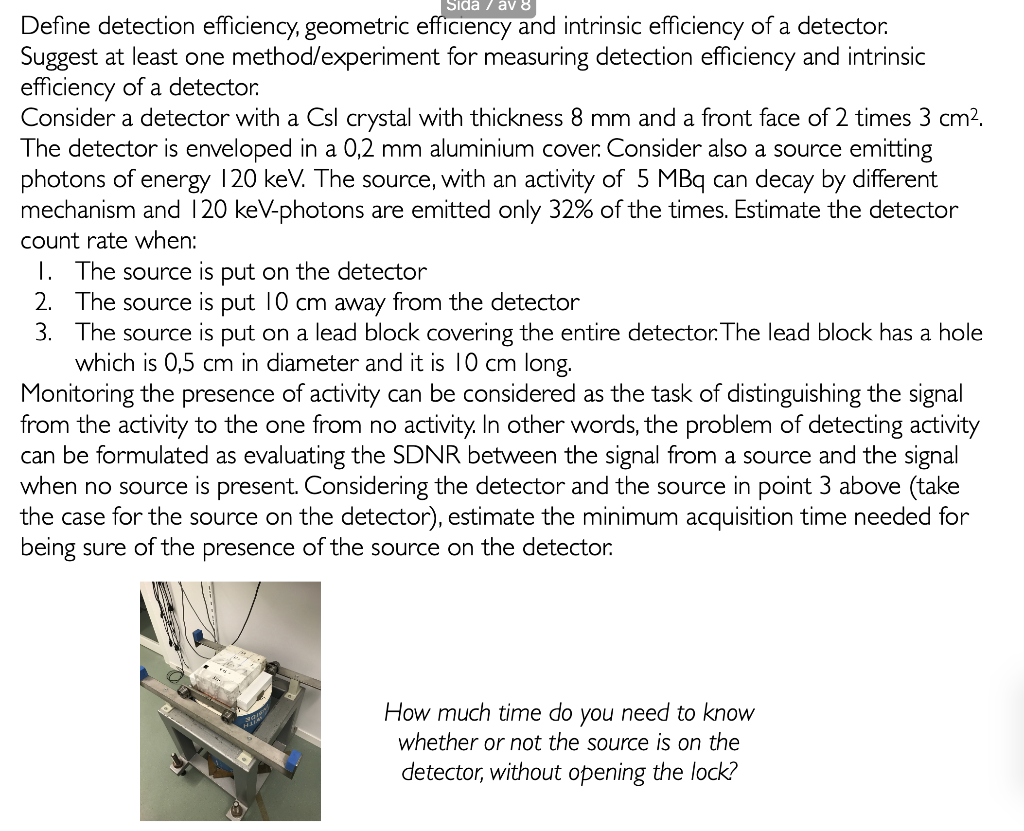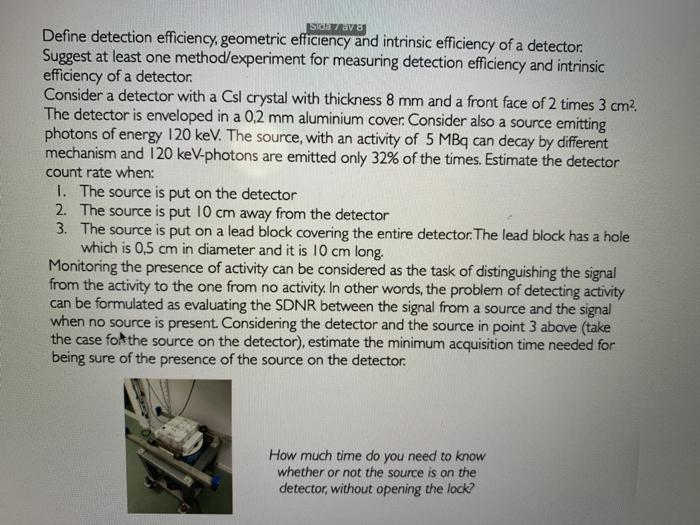
Sida / av 8 Define detection efficiency, geometric efficiency and intrinsic efficiency of a detector. Suggest at least one method/experiment for measuring detection efficiency and intrinsic efficiency of a detector. Consider a detector with a Csl crystal with thickness 8 mm and a front face of 2 times 3 cm2. The detector is enveloped in a 0,2 mm aluminium cover. Consider also a source emitting photons of energy 120 keV. The source, with an activity of 5 MBq can decay by different mechanism and 120 keV-photons are emitted only 32% of the times. Estimate the detector count rate when: 1. The source is put on the detector 2. The source is put 10 cm away from the detector 3. The source is put on a lead block covering the entire detector. The lead block has a hole which is 0,5 cm in diameter and it is 10 cm long. Monitoring the presence of activity can be considered as the task of distinguishing the signal from the activity to the one from no activity. In other words, the problem of detecting activity can be formulated as evaluating the SDNR between the signal from a source and the signal when no source is present. Considering the detector and the source in point 3 above (take the case for the source on the detector), estimate the minimum acquisition time needed for being sure of the presence of the source on the detector. How much time do you need to know whether or not the source is on the detector, without opening the lock? ISTO Tava Define detection efficiency, geometric efficiency and intrinsic efficiency of a detector Suggest at least one method/experiment for measuring detection efficiency and intrinsic efficiency of a detector. Consider a detector with a Csl crystal with thickness 8 mm and a front face of 2 times 3 cm2. The detector is enveloped in a 0,2 mm aluminium cover. Consider also a source emitting photons of energy 120 keV. The source, with an activity of 5 MBq can decay by different mechanism and 120 keV-photons are emitted only 32% of the times. Estimate the detector count rate when: 1. The source is put on the detector 2. The source is put 10 cm away from the detector 3. The source is put on a lead block covering the entire detector The lead block has a hole which is 0,5 cm in diameter and it is 10 cm long. Monitoring the presence of activity can be considered as the task of distinguishing the signal from the activity to the one from no activity. In other words, the problem of detecting activity can be formulated as evaluating the SDNR between the signal from a source and the signal when no source is present. Considering the detector and the source in point 3 above (take the case fol the source on the detector), estimate the minimum acquisition time needed for being sure of the presence of the source on the detector How much time do you need to know whether or not the source is on the detector, without opening the lock? Sida / av 8 Define detection efficiency, geometric efficiency and intrinsic efficiency of a detector. Suggest at least one method/experiment for measuring detection efficiency and intrinsic efficiency of a detector. Consider a detector with a Csl crystal with thickness 8 mm and a front face of 2 times 3 cm2. The detector is enveloped in a 0,2 mm aluminium cover. Consider also a source emitting photons of energy 120 keV. The source, with an activity of 5 MBq can decay by different mechanism and 120 keV-photons are emitted only 32% of the times. Estimate the detector count rate when: 1. The source is put on the detector 2. The source is put 10 cm away from the detector 3. The source is put on a lead block covering the entire detector. The lead block has a hole which is 0,5 cm in diameter and it is 10 cm long. Monitoring the presence of activity can be considered as the task of distinguishing the signal from the activity to the one from no activity. In other words, the problem of detecting activity can be formulated as evaluating the SDNR between the signal from a source and the signal when no source is present. Considering the detector and the source in point 3 above (take the case for the source on the detector), estimate the minimum acquisition time needed for being sure of the presence of the source on the detector. How much time do you need to know whether or not the source is on the detector, without opening the lock? ISTO Tava Define detection efficiency, geometric efficiency and intrinsic efficiency of a detector Suggest at least one method/experiment for measuring detection efficiency and intrinsic efficiency of a detector. Consider a detector with a Csl crystal with thickness 8 mm and a front face of 2 times 3 cm2. The detector is enveloped in a 0,2 mm aluminium cover. Consider also a source emitting photons of energy 120 keV. The source, with an activity of 5 MBq can decay by different mechanism and 120 keV-photons are emitted only 32% of the times. Estimate the detector count rate when: 1. The source is put on the detector 2. The source is put 10 cm away from the detector 3. The source is put on a lead block covering the entire detector The lead block has a hole which is 0,5 cm in diameter and it is 10 cm long. Monitoring the presence of activity can be considered as the task of distinguishing the signal from the activity to the one from no activity. In other words, the problem of detecting activity can be formulated as evaluating the SDNR between the signal from a source and the signal when no source is present. Considering the detector and the source in point 3 above (take the case fol the source on the detector), estimate the minimum acquisition time needed for being sure of the presence of the source on the detector How much time do you need to know whether or not the source is on the detector, without opening the lock








